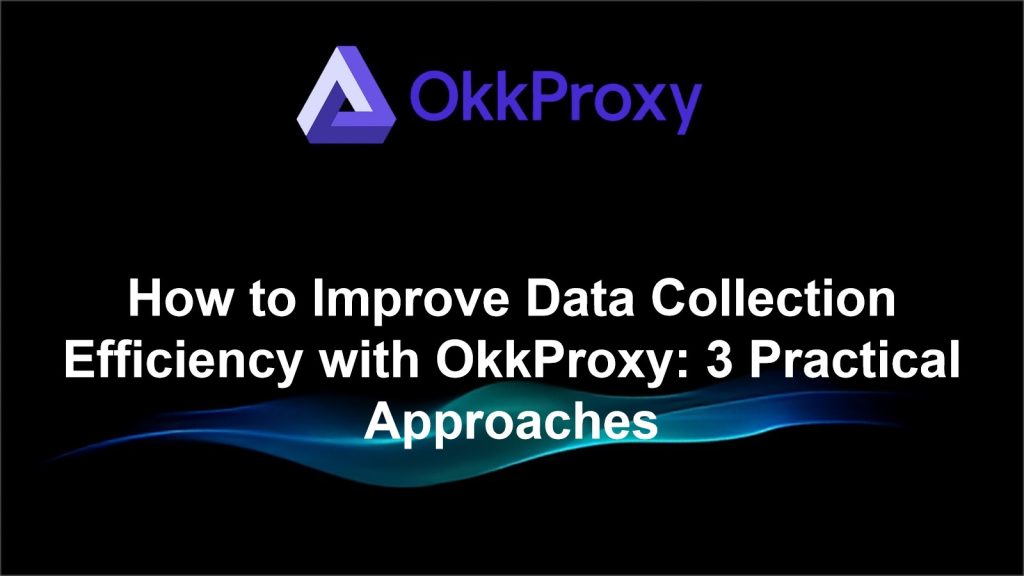1. Automation: Reducing Manual Intervention to Increase Efficiency
Manual data collection is time-consuming and prone to errors. Therefore, automating data scraping is the first step to improving efficiency.
How to Automate Data Scraping?
– Use web scraping frameworks like OkkProxy, Scrapy, Selenium, and others to collect data in bulk and support custom rules for accuracy.
– Schedule periodic tasks with Python’s schedule library or cron jobs to automate data collection.
– Use multi-threading and asynchronous requests with asyncio or ThreadPoolExecutor to speed up the process.
Advantages of Automation:
– Reduced Labor Costs: No more manual copy-paste work, freeing up productive resources.
– Increased Speed: Simultaneous multi-threading and task execution to speed up data collection.
– Enhanced Accuracy: Less human interference means more consistent and complete data.
2. Use of Data Sets: Reuse Existing Resources to Avoid Repeated Collection
If certain data you need has already been collected and is publicly available, using an existing data set is more efficient than scraping it yourself.
How to Find the Right Data Sets?
– Open-source data platforms like Kaggle, Google Dataset Search, and DataHub provide rich industry data.
– Government and enterprise APIs: Platforms like Twitter and Google Maps offer APIs to directly fetch structured data.
– Internal database queries: SQL, NoSQL databases can provide access to historical data.
Advantages of Using Data Sets:
– Saves Bandwidth & Storage: No need to collect and store data yourself, use existing structured data.
– Reduced Scraping Risks: Avoid IP restrictions and anti-scraping measures.
– Faster Analysis: Spend less time on data preprocessing, speeding up the analysis and decision-making process.
3. Leverage Proxies for Uninterrupted Data Scraping
For large-scale data collection, many websites impose restrictions on request frequency, block IPs, or set geo-location access limits, making data scraping inefficient. Using proxies is an effective solution to these problems.
Why Use Proxies?
– Bypass IP Restrictions: Use dynamic IP rotation to bypass anti-scraping measures, ensuring consistent data collection.
– Access Global Data: Use residential proxies or data center proxies to simulate access from different countries.
– Avoid Bans: Proxy IPs simulate real user behavior, reducing the risk of blocking and improving success rates.
Types of Proxies:
| Proxy Type | Use Case | Advantage |
| Residential Proxy | Access IP-restricted websites | High anonymity, simulates real users |
| Data Center Proxy | Large-scale data collection | High-speed, cost-effective |
| Static Residential Proxy | Long-term IP reputation | High reliability, hard to block |
| Mobile Proxy | Collect mobile data | High anonymity, frequent IP changes |
Why Choose OkkProxy for Data Collection?
– Global Coverage: Access proxies from over 180 countries to meet your data collection needs worldwide.
– Smart IP Rotation: Automatically rotate IPs to avoid blocking and improve the success rate of data collection.
– High Anonymity: Protect your real IP and prevent detection by websites.
– Multi-Region Support: Choose IPs from specific countries or cities for more accurate market data.
Conclusion
Efficient data collection is key for businesses to make data-driven decisions. To improve your collection efficiency.
1. Automate Data Scraping: Use tools like Scrapy, Selenium to reduce manual intervention.
2. Use Existing Data Sets: Leverage public data resources to avoid redundant collection.
3. Use Proxies to Overcome Restrictions: Utilize OkkProxy to achieve stable, efficient data collection.
If you’re looking for a stable and fast data collection solution, try OkkProxy and make your data collection process smoother and more efficient!
